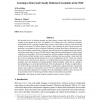29 search results - page 6 / 6 » On the Well-Behavedness of Important Attribute Evaluation Fu... |
TFS
2008
13 years 5 months ago
2008
Abstract--This paper considers the automatic design of fuzzyrule-based classification systems from labeled data. The performance of classifiers and the interpretability of generate...
MICCAI
2010
Springer
13 years 3 months ago
2010
Springer
Groupwise registration has been widely investigated in recent years due to its importance in analyzing population data in many clinical applications. To our best knowledge, most o...
JMLR
2006
13 years 5 months ago
2006
We describe the use of machine learning and data mining to detect and classify malicious executables as they appear in the wild. We gathered 1,971 benign and 1,651 malicious execu...
BMCBI
2004
13 years 5 months ago
2004
Background: In a previous paper, we introduced MUSCLE, a new program for creating multiple alignments of protein sequences, giving a brief summary of the algorithm and showing MUS...

